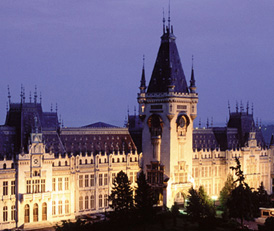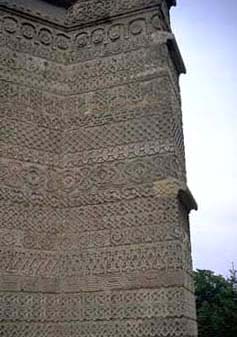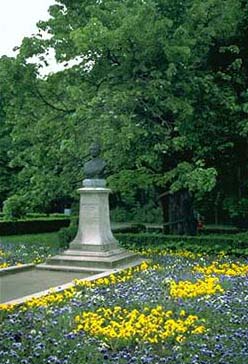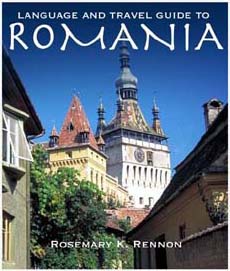MOLDAVIA
Moldavia is in northeastern Romania, bordering Ukraine and the Republic of Moldova. Its history can be traced back to 6,000 B.C and its Thracian-Dacian settlements. Moldavia’s hero is Stephen the Great, who fought back the Turks in the 15th century and built churches and monasteries throughout the region. Maps
 Bucovina
Bucovina
 This is a region of green, rolling hills dotted with Stephan the Great's small Byzantine churches, some of the most fascinating sights in Romania. There are five Painted Monasteries, whose exterior walls were painted with elaborate depictions of bible stories, still clearly visible after 600 years. In 1993 the painted churches were designated a World Heritage Site by UNESCO.
This is a region of green, rolling hills dotted with Stephan the Great's small Byzantine churches, some of the most fascinating sights in Romania. There are five Painted Monasteries, whose exterior walls were painted with elaborate depictions of bible stories, still clearly visible after 600 years. In 1993 the painted churches were designated a World Heritage Site by UNESCO.
The five painted churches are: Voronet, Humor, Sucevita, Moldavita and Arbore, each with a uniquely dominant color.
Suceava
Suceava is the largest city in Bucovina province and the main transportation connection to the Painted Monasteries. Suceava is mentioned in documents from the 14th century.
It's sights include:
Cetatea de Schaun (Schaun Citadel), built in 1388.
Ruins of Stephen’s Princely Court.
Petru Rares’ 16th-century St. Dimitru’s Church.
Zamca Medieval Complex, a monastery fortress for invading King Jan Sobieski of Poland in 1691.
Bucovina History Museum with medieval armor, coins, tools, ancient documents and the
Hall of Throne, a recreation of Stephen’s court with furniture, weapons and costumes.
The Folk Art Museum (Princely Inn) in a 16th century building includes pottery, folk dresses, handmade rugs and wooden objects.
The 14th century Mirauti church and 16th century Sfintu Gheorghe Nou (New Saint George) church.
Return to top
Iasi
Map
Iasi is the cultural capital of Moldavia and hub of intellectual life in Romania. It has the country’s oldest public University, founded in 1860, and is the home of many important literary figures.
 Iasi has museums of history, art, literature, ethnography, theatre and sound technology, plus memorial houses of famous Romanians, churches and monasteries from the 16th-19th centuries, a botanical garden and a fine theatre and philharmonic. Iasi's many interesting sights include: Iasi has museums of history, art, literature, ethnography, theatre and sound technology, plus memorial houses of famous Romanians, churches and monasteries from the 16th-19th centuries, a botanical garden and a fine theatre and philharmonic. Iasi's many interesting sights include:
The magnificent Palace of Culture, built 1900-1926, containing four museums: the Polytechnical Museum, with old pianolas, music boxes and gramophones among other gizmos; the Ethnographic Museum exhibiting regionsl costumes, handicrafts and tools; the Art Museum; and the Moldavian History Museum.
Church of St. Nicholas, built by Stephen the Great in 1492, restored in 1904.
 Trei Ierarahi Church built in 1639, its entire stone facade chiseled with intricate patterns; it holds the tombs of Princes Alexandru Ioan Cuza, Vasile Lupu, and scholar Dimitrie Cantemir.
Trei Ierarahi Church built in 1639, its entire stone facade chiseled with intricate patterns; it holds the tombs of Princes Alexandru Ioan Cuza, Vasile Lupu, and scholar Dimitrie Cantemir.
St. George Church built in 1761 with a 99-foot (30 m.) high bell tower once gilded in 18-carat gold.
Metropolitan Cathedral built in the 1830s, and the Metropolitan’s Palace.
The National Theatre, one of the most beautiful halls in all Europe, built in 1895 by Viennese architects.
Piata Unirii, with its bronze statue of Alexandru Ioan Cuza, who arranged the unification of Moldavia and Wallachia in 1859 and founded universities in Iasi and Bucharest.
The Union Museum (Cuza’s old house), built in 1806, containing original documents, sculptures and other items relating to the 1859 union.
Piata Eminescu, with a statue of poet Mihail Eminescu at its center.
University Libraries, the British Council Library and the Student Cultural House surrounding Piata Eminescu.
Voivodes Statuary, eight of Moldavia’s princes overlooking a tiny park.
Pogor House Literary Museum, 1850 meeting house of Vasile Pogor's Junimea literary society, with busts of literary society members such as Eminescu, Creanga and Caragiale.
 Eminescu Library and Cuza University in the Copou district.
Eminescu Library and Cuza University in the Copou district.
Copou Gardens where Eminescu wrote poetry under the linden tree;
the Alley of Statues of Romanian cultural notables;
an obelisk from 1834; several ponds, and a Museum of paintings and Eminescu memorabilia.
The Old University built in 1795; now the University of Medicine and Pharmacology.
The National History Museum.
The Great Synagogue, built in 1671, and its Jewish History Museum; also was home of the world’s first Yiddish Theatre
in 1876.
|
 A World of Adventure
A World of Adventure  A World of Adventure
A World of Adventure 
